Writing obituaries is the part of this job that really sucks.
I’ve been doing this column for a little over seven months now, and in that time I’ve had to write reminiscences of Dan Spiegle, Bernie Wrightson, and now Rich Buckler. Not to mention marking the first anniversary of Darwyn Cooke’s passing last week. And sadly, I know this won’t be the last one I’ll have to write.
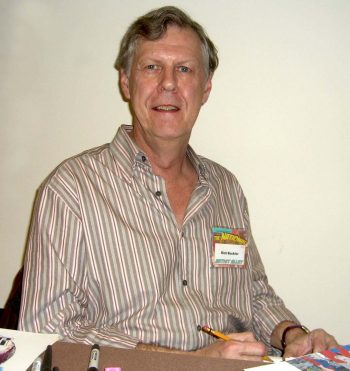 Buckler passed away on Friday due to complications from cancer at the age of 68. It came as a shock to me personally, as I had not even heard that he was ill. Sadly and ironically, I had just gotten an assignment this past Wednesday to do a short Q&A with Mr. Buckler for an upcoming issue of BACK ISSUE magazine. I was looking forward to it, as I hadn’t had the opportunity to interview Mr. Buckler before. I hate that I won’t get the chance to talk with him now.
Buckler passed away on Friday due to complications from cancer at the age of 68. It came as a shock to me personally, as I had not even heard that he was ill. Sadly and ironically, I had just gotten an assignment this past Wednesday to do a short Q&A with Mr. Buckler for an upcoming issue of BACK ISSUE magazine. I was looking forward to it, as I hadn’t had the opportunity to interview Mr. Buckler before. I hate that I won’t get the chance to talk with him now.
I’m not going to pretend that this will be a comprehensive look at Rich Buckler’s career. I’m honestly not qualified to do that, but I’m going to hit a few of the highlights of my time reading his work.
Rich Buckler had a long career in comics – If you name it, he probably drew it at some point. He had runs on Spider-Man, The Fantastic Four, The Avengers, Justice League of America, The Black Panther… he even ghosted the Ghost-Who-Walks himself, the Phantom, at one point. If you wanted a job penciled well and on-time, Rich Buckler was one of the guys you called.
At Marvel, he’s probably most remembered for creating Deathlok the Demolisher. (EDIT: I initially wrote “co-creator” here, but Jerry Ordway sent me this response on Twitter: “I was just reading an interview with Doug Moench, in Alter Ego, which spells out the ‘co-creator’ status of Deathlok, and based on Stan Lee’s theory of character creation, ‘I originated the name, or concept first,’ then Rich solo-created Deathlok, since he presented Marvel with a character and maybe 10 pages of finished drawn story. Whatever Moench contributed, it was after the fact.” I apologize for the inaccuracy. – JT)

Deathlok was a big switch from the typical comic book hero of the time. He was a cyborg in the post-apocalyptic near-future of 1990, battling the evil corporate regimes that had taken over the United States. The character was eventually incorporated into the Marvel Universe, and a few different Deathloks were introduced. A version of him was even featured on the Agents of S.H.I.E.L.D. television series.
But honestly, most of Buckler’s 1970s Marvel work was before my time. I first got to know Buckler as a DC artist in the early 80s, and that’s still how I think of him.
In 1981, Buckler penciled one of my favorite JLA stories, the two-part “The Return of the Starfish Conqueror!” (Justice League of America #189-190), where JLA writer Gerry Conway brought back Starro, the JLA’s very first foe from The Brave and the Bold #34. Buckler drew all sorts of cool shots of the Leaguers getting overwhelmed by fluttering, facehugging, mind-controlling starfish.
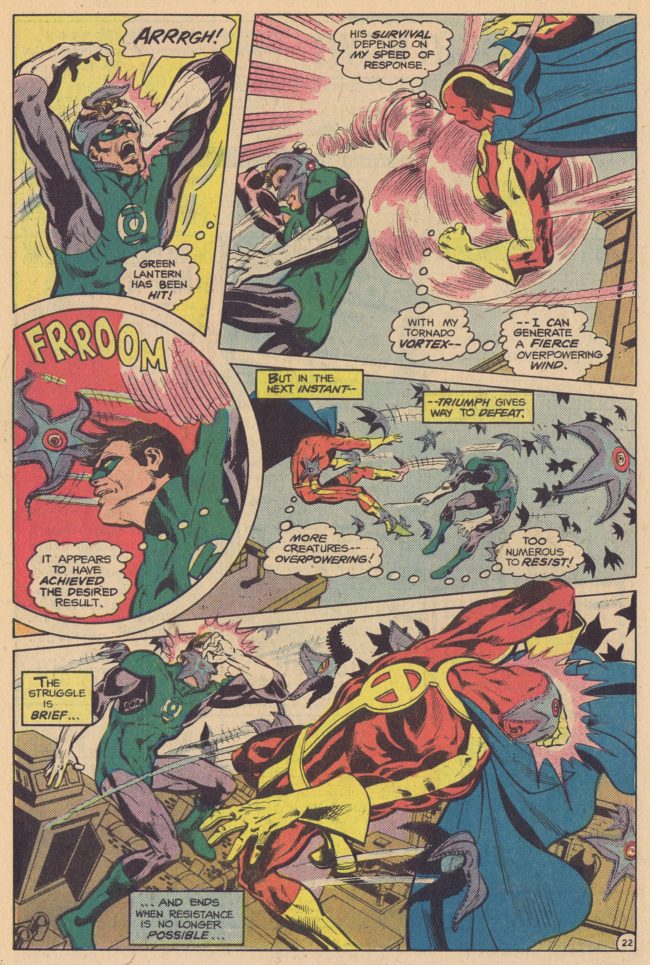
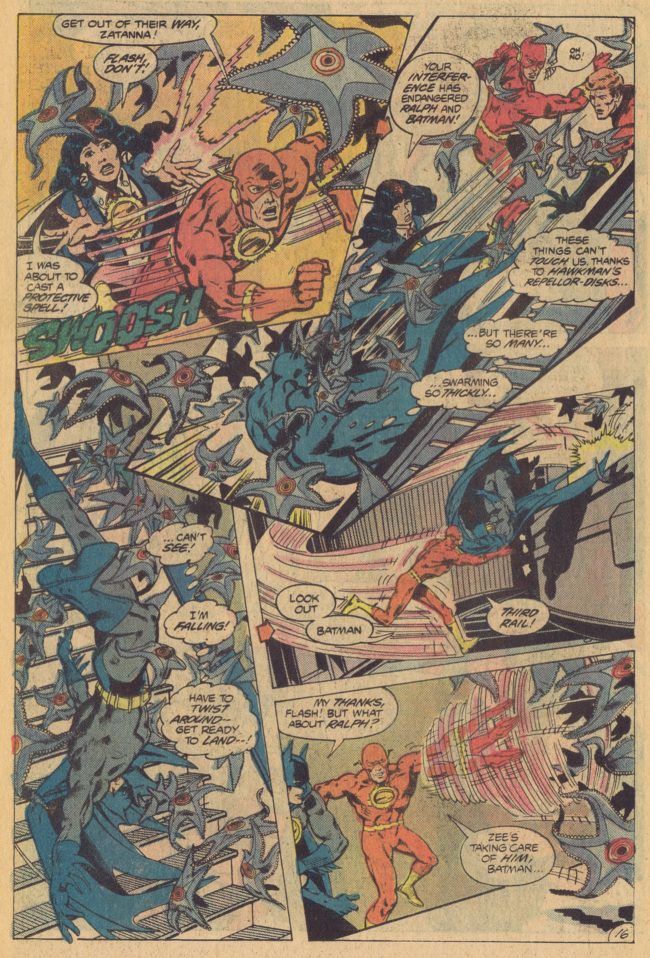
Later that year, Buckler became the co-creator and penciler on Roy Thomas’ All-Star Squadron.

This had to be one of the tougher assignments in comics at the time. Not only was it a group book, filled to the brim with superheroes and villains both famous and obscure, but it was a period book, taking place right after the U.S. entered World War II. So everything from clothes to cars to buildings had to look accurate to 1941. Not to mention likenesses for historical figures like FDR. Buckler (with the aid of embellisher Jerry Ordway) did it, and made it look easy.

Buckler also drew the occasional issue of DC Comics Presents, DC’s Superman team-up book. Here’s a favorite sequence of mine from 1982’s DCCP #45, where Superman reveals his secret identity to his fellow JLAer Firestorm, but not before having a little fun with him first:
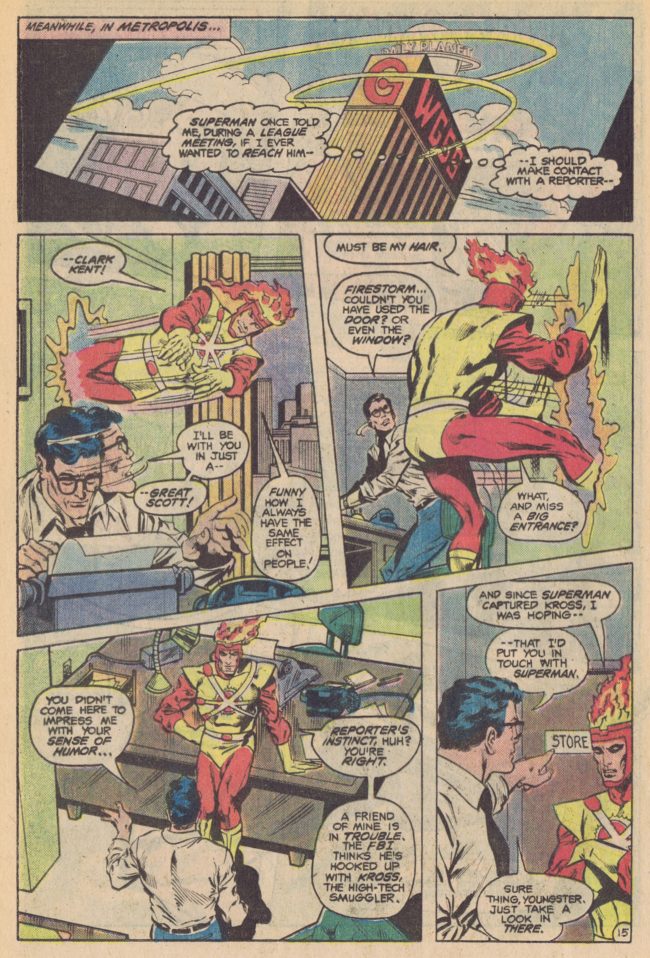
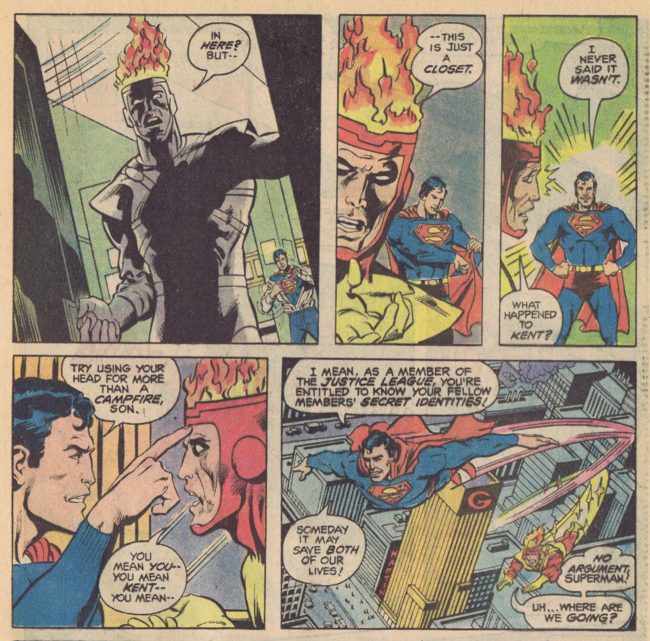
I’m also very fond of DCCP #49, a Superman/Captain Marvel team-up where they fought Black Adam, and met the Billy Batson of Earth-One:

But probably my favorite Buckler-drawn story is 1982’s DC Comics Presents Annual #1, where the Earth-One Superman teamed up with his counterpart from Earth-Two. Really, what ten-year old wouldn’t love a story with TWO Supermen, the Earth-One Lex Luthor switching places with Earth-Two’s Alexei Luthor, and Earth-Three’s Ultraman from the Crime Syndicate along for the ride as their henchman? I’m very fond of this sequence of the two Superman discussing the pros and cons of making a permanent commitment to Lois Lane. There’s some nice, subtle drama in Buckler’s staging of the scene:


This was also the story that first introduced Alexander Luthor (the “good” Luthor) and the Lois Lane of Earth-Three. You probably remember them from the pivotal cameo they made in Crisis on Infinite Earths #1.
Sometime in the late 70s, Buckler illustrated a Gerry Conway JLA story slated for a DC Treasury Edition. The story was shelved when the Treasury format went away, eventually seeing print in Justice League of America #s 210-212 (Jan.- Mar. 1983). It’s a crying shame that this story was never published at the giant size it was originally intended for. You can get more information on this story, plus an interview with Buckler, over at my friend Rob Kelly’s Treasury Comics site.

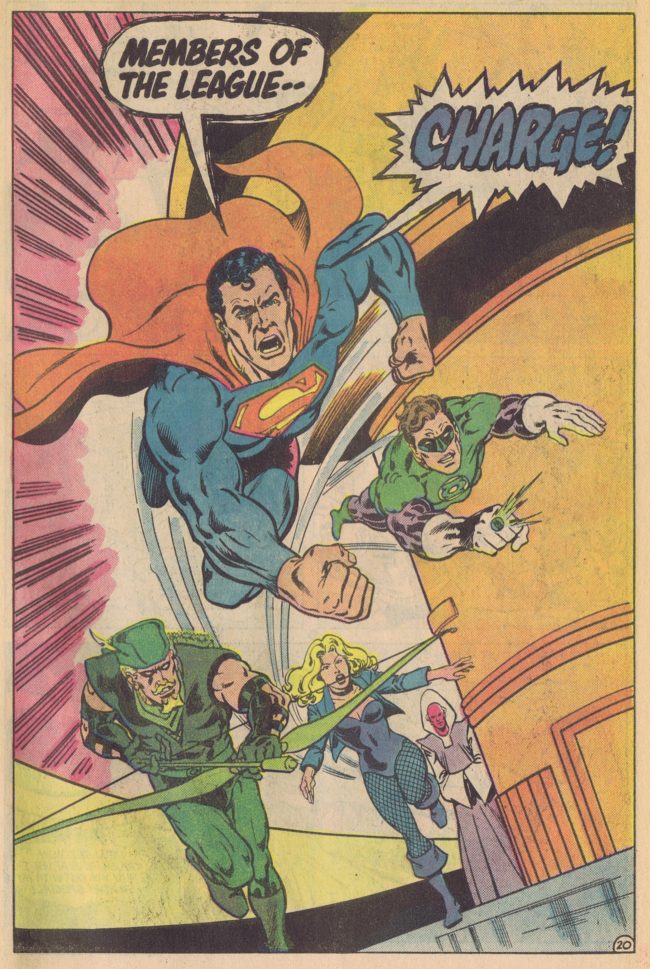
A few years back on the BACK ISSUE Facebook group I co-admin, some members were writing Buckler off as a “Swipe Artist,” criticizing him for the various swipes and homages in his work. Buckler actually came and commented on the thread, and he was a lot classier than I think I would have been in his shoes. The one sentence that sticks in my head was a somewhat defensive “I do know how to draw on my own, you know.” I was impressed with his response, and I made a point of telling him so when I briefly introduced myself to him at the East Coast Comicon a few months later. It was just a brief conversation, and I didn’t even think to take a picture with him. But again, he was very nice.
Buckler and I became Facebook friends in 2014, and when his birthday rolled around in 2015 I shared this homage I did of his classic cover to All-Star Squadron #1 on his FB page:

Buckler was nice enough to comment back: “Excellent everything on this one, John! I love it!” That was pretty cool to hear.
In more recent years, Buckler expanded beyond comic book art, becoming a surrealist painter in the tradition of Salvador Dali. Here’s a self portrait he did in 2001:
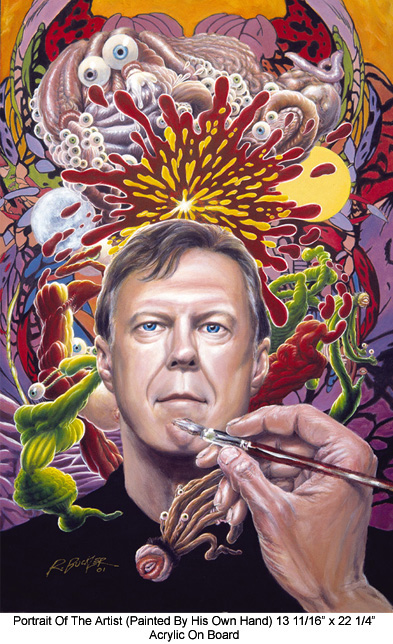
Daniel Best has a great series of essays over on his blog 20th Century Danny Boy where Buckler wrote all about his life and career. I highly encourage everyone reading this to check them out — It’s fascinating reading and I certainly learned a few things. I’ve added links to all eight parts below:
Part I – Early Days Of Comic Book Fandom
Part II – From Fan To Professional
Part III – Marvel & DC In The ’70s
Part IV – Marvel & DC In The ’70s, Part II
Part VI – D.C. Comics In The Late ’70s
Part VIII – Martial Arts & Movies
In addition to his own art, Buckler served as a mentor to many others in the comics field: George Pérez, Denys Cowan, Klaus Janson, Jackson Guice, Eduardo Barreto, Arvell Jones, Keith Pollard, and more — Buckler helped all of them get their start in comics.
Not a bad legacy.
R.I.P., Mr. Buckler. Thanks for all the great comic books.


RIP, Mr. Buckler.
Thanks for the nice column, John, and the great samples of Bucker’s art. I have very vivid memories of reading pretty much all of that stuff you posted.
Also, I hope you don’t mind if I post some links of my own: at around the same time Buckler wrote those posts at Daniel Best’s blog, he also contributed a bunch of guest posts for Diversions of the Groovy Kind, which all went under the title “Swash” Buckler Saturdays. And here’s a link to his first guest post at Diversions.
Title. Like the posts at 20th Century Danny Boy, they’re absolutely fascinating and well worth reading.
Thanks for sharing, Edo! I’m a fan of Diversions of the Groovy Kind, but it’s been a while since I’ve visited it.
I was just looking over those links (yours and mine – and almost got sucked into reading a bunch of those posts again), when I realized that Buckler had also written a few more posts at Diversions under the heading “Secrets Behind the Comics.” Here’s the links to those as well:
Part 1: Surreal, Sublime and Fantastic
Part 2: Ghost Who Draws
Part 3: Penciling and Inking
These are more focused on the technical aspects of making comics.
I don’t know how much I have by him, but he was a good artist. His work is just pleasant to look at; like the best of the Bronze Age. Reminds me a little of Neal Adams.
Yeah, Buckler’s natural style was definitely of the Adams school, IMO.
I always liked Buckler’s work, no matter the criticism. Wally Wood said “Never draw what you can swipe, never swipe what you can trace, never trace what you can photocopy, never photocopy what you can cut and paste.” Nearly every artist has copied something in their career, if only at the start. Buckler grew out of it and did some fine work. In the 70s, at DC, his covers were often light years ahead of the interiors. He also was editor of the revived Archie Red Circle line and did my favorite cover of the Mighty Crusaders, on issue #2, with a ton of MLJ heroes squaring off, on a wrap-around cover. Unfortunately, he also worked for Solson, which was about as bottom-feeding as it got, with umpteent TMNT rip-offs and Reagan’s Raiders (which was at least stupid fun). Deathlok even turned up in issues one of Reagan’s Raiders, which probably would have had Marvel on the phone to their lawyers, had it not been Solson and they were assured that no one would see it.
I’ve read at least one interview with Buckler and he came across as a decent, classy guy, who loved comics and working in the field. Can’t ask for much more than that.